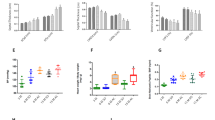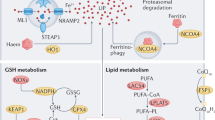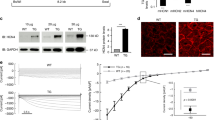Abstract
Under conditions of iron overload, which are now reaching epidemic proportions worldwide, iron-overload cardiomyopathy is the most important prognostic factor in patient survival. We hypothesize that in iron-overload disorders, iron accumulation in the heart depends on ferrous iron (Fe2+) permeation through the L-type voltage-dependent Ca2+ channel (LVDCC), a promiscuous divalent cation transporter. Iron overload in mice was associated with increased mortality, systolic and diastolic dysfunction, bradycardia, hypotension, increased myocardial fibrosis and elevated oxidative stress. Treatment with LVDCC blockers (CCBs; amlodipine and verapamil) at therapeutic levels inhibited the LVDCC current in cardiomyocytes, attenuated myocardial iron accumulation and oxidative stress, improved survival, prevented hypotension and preserved heart structure and function. Consistent with the role of LVDCCs in myocardial iron uptake, iron-overloaded transgenic mice with cardiac-specific overexpression of the LVDCC α1-subunit had twofold higher myocardial iron and oxidative stress levels, as well as greater impairment in cardiac function, compared with littermate controls; LVDCC blockade was again protective. Our results indicate that cardiac LVDCCs are key transporters of iron into cardiomyocytes under iron-overloaded conditions, and potentially represent a new therapeutic target to reduce the cardiovascular burden from iron overload.
This is a preview of subscription content, access via your institution
Access options
Subscribe to this journal
Receive 12 print issues and online access
$209.00 per year
only $17.42 per issue
Buy this article
- Purchase on Springer Link
- Instant access to full article PDF
Prices may be subject to local taxes which are calculated during checkout




Similar content being viewed by others
References
Weatherall, D.J. & Clegg, J.B. Thalassemia—a global public health problem. Nat. Med. 2, 847–849 (1996).
Barton, J.C. & Bertoli, L.F. Hemochromatosis: the genetic disorder of the twenty-first century. Nat. Med. 2, 394–395 (1996).
Andrews, N.C. Disorders of iron metabolism. N. Engl. J. Med. 341, 1986–1995 (1999).
Ballas, S.K. Iron overload is a determinant of morbidity and mortality in adult patients with sickle cell disease. Semin. Hematol. 38, 30–36 (2001).
Weatherall, D.J. & Clegg, J.B. Inherited haemoglobin disorders: an increasing global health problem. Bull. World Health Organ. 79, 704–712 (2001).
Roy, C.N. & Andrews, N.C. Recent advances in disorders of iron metabolism: mutations, mechanisms and modifiers. Hum. Mol. Genet. 10, 2181–2186 (2001).
Buja, L.M. & Roberts, W.C. Iron in the heart. Etiology and clinical significance. Am. J. Med. 51, 209–221 (1971).
Low, L.C. Growth, puberty and endocrine function in beta-thalassaemia major. J. Pediatr. Endocrinol. Metab. 10, 175–184 (1997).
Weatherall, D.J. Phenotype-genotype relationships in monogenic disease: lessons from the thalassaemias. Nat. Rev. Genet. 2, 245–255 (2001).
Zurlo, M.G. et al. Survival and causes of death in thalassaemia major. Lancet 2, 27–30 (1989).
Olivieri, N.F. et al. Survival in medically treated patients with homozygous beta- thalassemia. N. Engl. J. Med. 331, 574–578 (1994).
Brittenham, G.M. et al. Efficacy of deferoxamine in preventing complications of iron overload in patients with thalassemia major. N. Engl. J. Med. 331, 567–573 (1994).
Niederau, C. et al. Long-term survival in patients with hereditary hemochromatosis. Gastroenterology 110, 1107–1119 (1996).
Cecchetti, G. et al. Cardiac alterations in 36 consecutive patients with idiopathic haemochromatosis: polygraphic and echocardiographic evaluation. Eur. Heart J. 12, 224–230 (1991).
Muhlestein, J.B. Cardiac abnormalities in hemochromatosis. in Hemochromatosis: Genetics, Pathophysiology, Diagnosis, and Treatment. (eds. Barton, J.C. & Edwards, C.Q.) 297–310 (Cambridge University Press, Cambridge, 2000).
Palka, P., Macdonald, G., Lange, A. & Burstow, D.J. The role of Doppler left ventricular filling indexes and Doppler tissue echocardiography in the assessment of cardiac involvement in hereditary hemochromatosis. J. Am. Soc. Echocardiogr. 15, 884–890 (2002).
Kremastinos, D.T. et al. Left ventricular diastolic Doppler characteristics in beta- thalassemia major. Circulation 88, 1127–1135 (1993).
Liu, P. & Olivieri, N. Iron overload cardiomyopathies: new insights into an old disease. Cardiovasc. Drugs Ther. 8, 101–110 (1994).
Gharzuddine, W.S. et al. Doppler characterization of left ventricular diastolic function in beta-thalassaemia major. Evidence for an early stage of impaired relaxation. Eur. J. Echocardiogr. 3, 47–51 (2002).
Jensen, C.E. et al. Incidence of endocrine complications and clinical disease severity related to genotype analysis and iron overload in patients with beta-thalassaemia. Eur. J. Haematol. 59, 76–81 (1997).
Strohmeyer, G. & Niederau, C. Diabetes mellitus and hemochromatosis. in Hemochromatosis: Genetics, Pathophysiology, Diagnosis, and Treatment. (eds. Barton, J.C. & Edwards, C.Q.) 268–277 (Cambridge University Press, Cambridge, 2000).
Niederau, C. et al. Survival and causes of death in cirrhotic and in noncirrhotic patients with primary hemochromatosis. N. Engl. J. Med. 313, 1256–1262 (1985).
Olivieri, N.F. The beta-thalassemias. N. Engl. J. Med. 341, 99–109 (1999).
Modell, B., Khan, M. & Darlison, M. Survival in beta-thalassaemia major in the UK: data from the UK Thalassaemia Register. Lancet 355, 2051–2052 (2000).
Galanello, R. Iron chelation: new therapies. Semin. Hematol. 38, 73–76 (2001).
Chaston, T.B. & Richardson, D.R. Iron chelators for the treatment of iron overload disease: Relationship between structure, redox activity, and toxicity. Am. J. Hematol. 73, 200–210 (2003).
Link, G., Pinson, A. & Hershko, C. Heart cells in culture: a model of myocardial iron overload and chelation. J. Lab. Clin. Med. 106, 147–153 (1985).
Randell, E.W., Parkes, J.G., Olivieri, N.F. & Templeton, D.M. Uptake of non-transferrin-bound iron by both reductive and nonreductive processes is modulated by intracellular iron. J. Biol. Chem. 269, 16046–16053 (1994).
Templeton, D.M. & Liu, Y. Genetic regulation of cell function in response to iron overload or chelation. Biochim. Biophys. Acta 1619, 113–124 (2003).
Parkes, J.G., Olivieri, N.F. & Templeton, D.M. Characterization of Fe2+ and Fe3+ transport by iron-loaded cardiac myocytes. Toxicology 117, 141–151 (1997).
Gunshin, H. et al. Iron-dependent regulation of the divalent metal ion transporter. FEBS Lett. 509, 309–316 (2001).
Tsushima, R.G. et al. Modulation of iron uptake in heart by L-type Ca2+ channel modifiers: possible implications in iron overload. Circ. Res. 84, 1302–1309 (1999).
Winegar, B.D., Kelly, R. & Lansman, J.B. Block of current through single calcium channels by Fe, Co, and Ni. Location of the transition metal binding site in the pore. J. Gen. Physiol. 97, 351–367 (1991).
Gunshin, H. et al. Cloning and characterization of a mammalian proton-coupled metal-ion transporter. Nature 388, 482–488 (1997).
Muth, J.N., Varadi, G. & Schwartz, A. Use of transgenic mice to study voltage-dependent Ca2+ channels. Trends Pharmacol. Sci. 22, 526–532 (2001).
Catterall, W.A. Structure and regulation of voltage-gated Ca2+ channels. Annu. Rev. Cell. Dev. Biol. 16, 521–555 (2000).
Wang, S.Q., Song, L.S., Lakatta, E.G. & Cheng, H. Ca2+ signalling between single L-type Ca2+ channels and ryanodine receptors in heart cells. Nature 410, 592–596 (2001).
Peri, R., Triggle, D.J. & Singh, S. Regulation of L-type calcium channels in pituitary GH(4)C(1) cells by depolarization. J. Biol. Chem. 276, 31667–31673 (2001).
Ligon, B., Boyd, A.E., 3rd & Dunlap, K. Class A calcium channel variants in pancreatic islets and their role in insulin secretion. J. Biol. Chem. 273, 13905–13911 (1998).
Kivisto, K.T., Neuvonen, P.J. & Tarssanen, L. Pharmacokinetics of verapamil in overdose. Hum. Exp. Toxicol. 16, 35–37 (1997).
Mikus, G. et al. Interaction of verapamil and cimetidine: stereochemical aspects of drug metabolism, drug disposition and drug action. J. Pharmacol. Exp. Ther. 253, 1042–1048 (1990).
Carvalho, M. et al. Amlodipine bioequivalence study: quantification by liquid chromatography coupled to tandem mass spectrometry. Biopharm. Drug Dispos. 22, 383–390 (2001).
Rychkov, G., Brereton, H.M., Harland, M.L. & Barritt, G.J. Plasma membrane Ca2+ release-activated Ca2+ channels with a high selectivity for Ca2+ identified by patch-clamp recording in rat liver cells. Hepatology 33, 938–947 (2001).
Link, G., Konijn, A.M. & Hershko, C. Cardioprotective effect of alpha-tocopherol, ascorbate, deferoxamine, and deferiprone: mitochondrial function in cultured, iron-loaded heart cells. J. Lab. Clin. Med. 133, 179–188 (1999).
Hershko, C., Link, G. & Pinson, A. Modification of iron uptake and lipid peroxidation by hypoxia, ascorbic acid, and alpha-tocopherol in iron-loaded rat myocardial cell cultures. J. Lab. Clin. Med. 110, 355–361 (1987).
Young, I.S. et al. Antioxidant status and lipid peroxidation in hereditary haemochromatosis. Free Radic. Biol. Med. 16, 393–397 (1994).
Livrea, M.A. et al. Oxidative stress and antioxidant status in beta-thalassemia major: iron overload and depletion of lipid-soluble antioxidants. Blood 88, 3608–3614 (1996).
Fuhr, U. et al. Effects of grapefruit juice and smoking on verapamil concentrations in steady state. Eur. J. Clin. Pharmacol. 58, 45–53 (2002).
Muller, F.B. et al. Once a day verapamil in essential hypertension. Br. J. Clin. Pharmacol. 21 (suppl. 2), 143S–147S (1986).
Dilger, K. et al. Chronopharmacology of intravenous and oral modified release verapamil. Br. J. Clin. Pharmacol. 47, 413–419 (1999).
Song, L.S. et al. Ca(2+) signaling in cardiac myocytes overexpressing the alpha(1) subunit of L-type Ca(2+) channel. Circ. Res. 90, 174–181 (2002).
Kremastinos, D.T., Tiniakos, G., Theodorakis, G.N., Katritsis, D.G. & Toutouzas, P.K. Myocarditis in beta-thalassemia major. A cause of heart failure. Circulation 91, 66–71 (1995).
McKie, A.T. et al. An iron-regulated ferric reductase associated with the absorption of dietary iron. Science 291, 1755–1759 (2001).
Andrews, N.C. Metal transporters and disease. Curr. Opin. Chem. Biol. 6, 181–186 (2002).
Ferris, C.D. et al. Haem oxygenase-1 prevents cell death by regulating cellular iron. Nat. Cell Biol. 1, 152–157 (1999).
Esterbauer, H., Schaur, R.J. & Zollner, H. Chemistry and biochemistry of 4-hydroxynonenal, malonaldehyde and related aldehydes. Free Radic. Biol. Med. 11, 81–128 (1991).
Lee, S.H., Oe, T. & Blair, I.A. Vitamin C-induced decomposition of lipid hydroperoxides to endogenous genotoxins. Science 292, 2083–2086 (2001).
Cohn, R.D. et al. Prevention of cardiomyopathy in mouse models lacking the smooth muscle sarcoglycan-sarcospan complex. J. Clin. Invest. 107, R1–R7 (2001).
Abernethy, D.R. & Schwartz, J.B. Calcium-antagonist drugs. N. Engl. J. Med. 341, 1447–1457 (1999).
ENCORE Investigators. Effect of nifedipine and cerivastatin on coronary endothelial function in patients with coronary artery disease: the ENCORE I Study (Evaluation of Nifedipine and Cerivastatin On Recovery of coronary Endothelial function). Circulation 107, 422–428 (2003).
Mason, R.P., Mak, I.T., Trumbore, M.W. & Mason, P.E. Antioxidant properties of calcium antagonists related to membrane biophysical interactions. Am. J. Cardiol. 84, 16L–22L (1999).
Nawrath, H. & Wegener, J.W. Kinetics and state-dependent effects of verapamil on cardiac L-type calcium channels. Naunyn Schmiedebergs Arch. Pharmacol. 355, 79–86 (1997).
Kass, R.S., Arena, J.P. & Chin, S. Cellular electrophysiology of amlodipine: probing the cardiac L-type calcium channel. Am. J. Cardiol. 64, 35I–41I (1989).
Luo, X.P., Yazdanpanah, M., Bhooi, N. & Lehotay, D.C. Determination of aldehydes and other lipid peroxidation products in biological samples by gas chromatography-mass spectrometry. Anal. Biochem. 228, 294–298 (1995).
Crackower, M.A. et al. Regulation of myocardial contractility and cell size by distinct PI3K-PTEN signaling pathways. Cell 110, 737–749 (2002).
Acknowledgements
We acknowledge the financial support from the Canadian Institute for Health Research (P.H.B. and P.L.); Heart and Stroke Foundation of Ontario (P.H.B. and P.L. and the US National Institutes of Health (P01 HL22619 to A.S.; NIH Training Grant T32 HL07382 to A.S. and S.E.K.) G.Y.O. is a recipient of a Postdoctoral Fellowship from the Canadian Institute for Health Research and the Heart and Stroke Foundation of Canada, and P.H.B. is a Career Investigator of the Heart and Stroke Foundation of Ontario. Technical assistance from P. Wilson and S. Omar is gratefully acknowledged. We thank Pfizer Inc. for measuring plasma amlodipine levels. This work was presented as an abstract at the American Heart Association Meetings in Anaheim, California, 2001 and Chicago, Illinois, 2002.
Author information
Authors and Affiliations
Corresponding author
Ethics declarations
Competing interests
The authors declare no competing financial interests.
Rights and permissions
About this article
Cite this article
Oudit, G., Sun, H., Trivieri, M. et al. L-type Ca2+ channels provide a major pathway for iron entry into cardiomyocytes in iron-overload cardiomyopathy. Nat Med 9, 1187–1194 (2003). https://doi.org/10.1038/nm920
Received:
Accepted:
Published:
Issue Date:
DOI: https://doi.org/10.1038/nm920
This article is cited by
-
The role of iron metabolism in chronic diseases related to obesity
Molecular Medicine (2022)
-
Liver Cancer Cells Uptake Labile Iron via L-type Calcium Channel to Facilitate the Cancer Cell Proliferation
Cell Biochemistry and Biophysics (2021)
-
Advancement of echocardiography for surveillance of iron overload cardiomyopathy: comparison to cardiac magnetic resonance imaging
Journal of Echocardiography (2021)
-
Hepcidin Peptide Inhibitor as Cardioprotection by Targeting Oxidative Stress and Inflammation in Type 1 Diabetic
International Journal of Peptide Research and Therapeutics (2020)
-
L-type Calcium Channels are Involved in Iron-induced Neurotoxicity in Primary Cultured Ventral Mesencephalon Neurons of Rats
Neuroscience Bulletin (2020)



